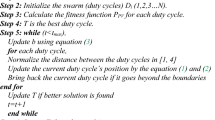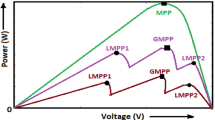Abstract
Solar photovoltaic (SPV) systems are becoming key emerging technologies for both stand-alone and grid-connected power system applications. However, uncertainty in environmental conditions such as temperature and irradiation dominates the performance of the SPV system. Due to uncertainty in environmental conditions, there should be drastic reduction in output power, efficiency and higher mismatch power loss in the SPV system. This adverse phenomenon can be overawed by the inclusion of bypass diode. But the inclusion will result in multiple peaks that are developed in the P–V curve. This will necessitate a robust MPPT controller to track the global maximum power (GMP) under PSCs. Various conventional (P&O, InC etc.) and optimization algorithms are described in the literature, but they are unsuccessful to identify GMP among multiple peaks. This paper proposes a novel hybrid slime mould assisted with perturb and observe (P&O) MPPT approach (HSMO) with hybrid bridge link-honey comb (BL-HC) configured PV system to enhance the better maximum power under PSCs. The proposed work is carried out in MATLAB/Simulink environment. Also, the performance of proposed HSMO technique is compared with the latest adaptive coefficient PSO (ACPSO), Flower Pollination algorithm (FPA), and slime mould optimization (SMO) MPPT techniques in terms of tracked GMP, tracking efficiency, and convergence time/tracking speed. The results of the proposed HSMO technique also demonstrate its supremacy in terms of tracked GMP, convergence time, and efficiency.












Similar content being viewed by others

References
Alajmi, B. N., Ahmed, K. H., Finney, S. J., & Williams, B. W. (2010). Fuzzy-logic-control approach of a modified hill-climbing method for maximum power point in microgrid standalone photovoltaic system. IEEE Transactions on Power Electronics, 26(4), 1022–1030.
Bollipo, R., Mikkili, S., & Bonthagorla, P. (2019). Critical review on PV MPPT techniques: Classical, intelligent and optimization. IET Renewable Power Generation, 14(9), 1433–1452.
Bollipo, R., Mikkili, S., & Bonthagorla, P. K. (2021). Application of radial basis neural network in MPPT technique for stand-alone PV system under partial shading conditions. IETE Journal of Research. https://doi.org/10.1080/03772063.2021.1988874
Bonthagorla, P. K., & Mikkili, S. (2021). A novel fixed PV array configuration for harvesting maximum power from shaded modules by reducing the number of cross-ties. IEEE Journal of Emerging and Selected Topics in Power Electronics, 9(2), 2109–2121. https://doi.org/10.1109/JESTPE.2020.2979632
Eltamaly, A. M., & Farh, H. M. (2019). Dynamic global maximum power point tracking of the PV systems under variant partial shading using hybrid GWO-FLC. Solar Energy, 177, 306–316.
Houam, Y., Terki, A., & Bouarroudj, N. (2021). An efficient metaheuristic technique to control the maximum power point of a partially shaded photovoltaic system using crow search algorithm (CSA). Journal of Electrical Engineering & Technology, 16, 381–402.
Howard, F. L. (1931). the life history of Physarum polycephalum. American Journal of Botany, 18(2), 116–133. https://doi.org/10.1002/j.1537-2197.1931.tb09577
Jiang, Y., Xu, J., Leng, X., & Eghbalian, N. (2022). A novel hybrid maximum power point tracking method based on improving the effectiveness of different configuration partial shadow. Sustainable Energy Technologies and Assessment, 50, 101835.
Kamarzaman, N. A., & Tan, C. W. (2014). A comprehensive review of maximum power point tracking algorithms for photovoltaic systems. Renewable and Sustainable Energy Reviews, 37, 585–598.
Khare, A., & Rangnekar, S. (2013). A review of particle swarm optimization and its applications in solar photovoltaic system. Applied Soft Computing, 13(5), 2997–3006.
Kota, V. R., & Bhukya, M. N. (2019). A novel global mpp tracking scheme based on shading pattern identification using artificial neural networks for photovoltaic power generation during partial shaded condition. IET Renewable Power Generation, 13(10), 1647–1659.
Kumar, J. C. R., & Majid, M. A. (2020). Renewable energy for sustainable development in India: Current status, future prospects, challenges, employment, and investment opportunities. Energy, Sustainability and Society, 10, 1–36.
Kumar, N., Hussain, I., Singh, B., & Panigrahi, B. K. (2017). Maximum power peak detection of partially shaded PV panel by using intelligent monkey king evolution algorithm. IEEE Transactions on Industry Applications, 53(6), 5734–5743.
Kumar, N., Hussain, I., Singh, B., & Panigrahi, B. K. (2018). Framework of maximum power extraction from solar pv panel using self-predictive perturb and observe algorithm. IEEE Transactions on Sustainable Energy, 9(2), 895–903.
Laxman, B., Annamraju, A., & Srikanth, N. V. (2021). A grey wolf optimized fuzzy logic based MPPT for shaded solar photovoltaic systems in microgrids. International Journal of Hydrogen Energy, 46, 10653–10665.
Mirza, A. F., Mansoor, M., & Ling, Q. (2020). A novel MPPT technique based on Henry gas solubility optimization. Energy Conversion and Management. https://doi.org/10.1016/j.enconman.2020.113409
Mirza, A. F., Mansoor, M., Ling, Q., Baoqun Yin, M., & Javed, Y. (2020). A salp-swarm optimization based MPPT technique for harvesting maximum energy from PV systems under partial shading conditions. Energy Conversion and Management. https://doi.org/10.1016/j.enconman.2020.112625
Mohammadinodoushan, M., Abbassi, R., Jerbi, H., Waly Ahmed, F., Abdalqadir khahmed, H., & Rezvani, A. (2021). A new MPPT design using variable step size perturb and observe method for PV system under partially shaded conditions by modified shuffled frog leaping algorithm—SMC controller. Sustainable Energy Technologies and Assessment, 45, 101056.
Mohanty, S., Subudhi, B., & Ray, P. K. (2015). A new MPPT design using grey wolf optimization technique for photovoltaic system under partial shading conditions. IIEEE Transactions on Sustainable Energy, 7, 181–188.
Mohanty, S., Subudhi, B., & Ray, P. K. (2016). A new MPPT design using grey wolf optimization technique for photovoltaic system under partial shading conditions. IEEE Transactions on Sustainable Energy, 7(1), 181–188.
Molleti, V. P. L., Kasibhatla, R., & Rajamahanthi, V., (2022). Modeling and implementation of statechart for MPPT control of photovoltaic system in FPGA. In Machine Learning, Advances in Computing, Renewable Energy and Communication, (pp.293–304). Springer: Singapore
Nakagaki, T., Yamada, H., & Ueda, T. (2000). Interaction between cell shape and contraction pattern in the Physarum plasmodium. Biophysical Chemistry, 84(3), 195–204.
Onyshchenko, V. F., et al. (2020). Photoconductivity relaxation time in macroporous silicon. Emerging Science Journal, 4(3), 192–204. https://doi.org/10.28991/esj-2020-01223
Pillai, D. S., Ram, J. P., Ghias, A. M., Mahmud, M. A., & Rajasekar, N. (2019). An accurate, shade detection-based hybrid maximum power point tracking approach for PV systems. IEEE Transactions on Power Electronics, 35, 6594–6608.
Qerimi, D., et al. (2020). Modeling of the solar thermal energy use in urban areas. Civil Engineering Journal, 6(7), 1349–1367. https://doi.org/10.28991/cej-2020-03091553
Rakhshan, M., Vafamand, N., Khooban, M.-H., & Blaabjerg, F. (2018). Maximum power point tracking control of photovoltaic systems: A polynomial fuzzy model-based approach. IEEE Journal of Emerging and Selected Topics in Power Electronics, 6(1), 292–299.
Renewables 2020. Available online: https://www.iea.org/reports/renewables-2020 (accessed on 1 March 2022).
Seyedmahmoudian, M., Kok Soon, T., Jamei, E., Thirunavukkarasu, G. S., Horan, B., Mekhilef, S., & Stojcevski, A. (2018). Maximum power point tracking for photovoltaic systems under partial shading conditions using bat algorithm. Sustainability, 10(5), 1347.
Shaw, S. et al., (2021). The global circular economy for the electric power industry and opportunities for solar photovoltaics. In: 2021 IEEE 48th Photovoltaic Specialists Conference (PVSC), Fort Lauderdale, (pp.1594–1599). https://doi.org/10.1109/PVSC43889.2021.9518899.
Singh, N., Gupta, K. K., Jain, S. K., Dewangan, N. K., & Bhatnagar, P. (2020). A flying squirrel search optimization for MPPT under partial shaded photovoltaic system. IIEEE Journal of Emerging and Selected Topics in Power Electronics 9, 4963–4978.
Singh, S. (2021). Environmental energy harvesting techniques to power standalone IoT-equipped sensor and its application in 5G communication. Emerging Science Journal, 4, 116–126. https://doi.org/10.28991/esj-2021-SP1-08
Subramanian, A., & Jayaparvathy, R. (2022). Performance comparison of modified elephant herding optimization tuned MPPT for PV based solar energy systems. Circuit World, 48(3), 309–321.
Subudhi, B., & Pradhan, R. (2013). A comparative study on maximum power point tracking techniques for photovoltaic power systems. IEEE Transactions on Sustainable Energy, 4(1), 89–98.
Sundareswaran, K., Sankar, P., Nayak, P. S. R., Simon, S. P., & Palani, S. (2014). Enhanced energy output from a PV system under partial shaded conditions through artificial bee colony. IEEE Transactions on Sustainable Energy, 6(1), 198–209.
Zhao, Z., Cheng, R., Yan, B., Zhang, J., Zhang, Z., Zhang, M., & Lai, L. L. (2020). A dynamic particles MPPT method for photovoltaic systems under partial shading conditions. Energy CConversion and Management 220, 113070.
Funding
The authors wish to thank the Science and Engineering Research Board (SERB), Department of Science and Technology, Government of India, for financial assistance provided under Grant number: EEQ/2021/000294.
Author information
Authors and Affiliations
Corresponding author
Additional information
Publisher's Note
Springer Nature remains neutral with regard to jurisdictional claims in published maps and institutional affiliations.
Appendix
Rights and permissions
Springer Nature or its licensor (e.g. a society or other partner) holds exclusive rights to this article under a publishing agreement with the author(s) or other rightsholder(s); author self-archiving of the accepted manuscript version of this article is solely governed by the terms of such publishing agreement and applicable law.
About this article
Cite this article
Bonthagorla, P.K., Mikkili, S. A Novel Hybrid Slime Mould MPPT Technique for BL-HC Configured Solar PV System Under PSCs. J Control Autom Electr Syst 34, 782–795 (2023). https://doi.org/10.1007/s40313-023-00996-5
Received:
Revised:
Accepted:
Published:
Issue Date:
DOI: https://doi.org/10.1007/s40313-023-00996-5



